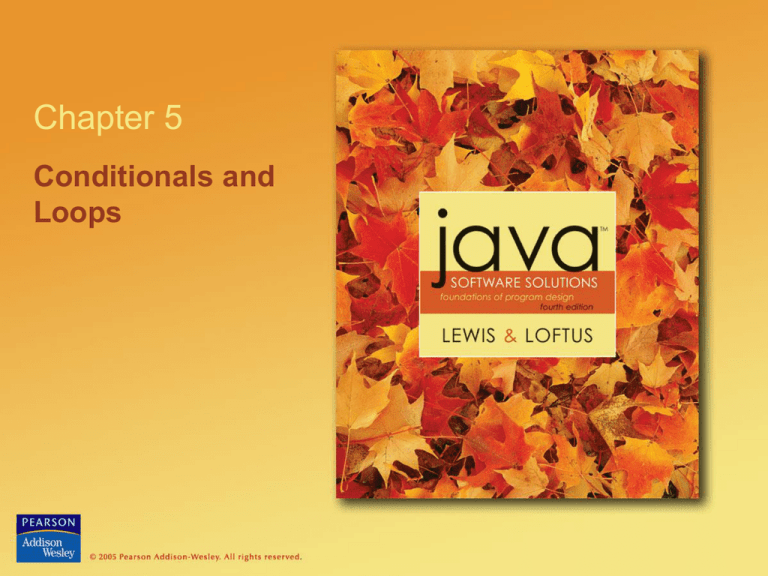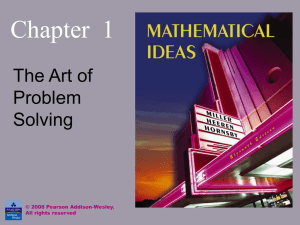
Chapter 5
Conditionals and
Loops
Conditionals and Loops
• Now we will examine programming statements that
allow us to:
make decisions
repeat processing steps in a loop
• Chapter 5 focuses on:
boolean expressions
conditional statements
comparing data
repetition statements
iterators
more drawing techniques
more GUI components
© 2004 Pearson Addison-Wesley. All rights reserved
5-2
Flow of Control
• Unless specified otherwise, the order of statement
execution through a method is linear: one
statement after another in sequence
• Some programming statements allow us to:
decide whether or not to execute a particular statement
execute a statement over and over, repetitively
• These decisions are based on boolean expressions
(or conditions) that evaluate to true or false
• The order of statement execution is called the flow
of control
© 2004 Pearson Addison-Wesley. All rights reserved
5-3
Programmet tar beslut
import java.util.*;
class Program51
{
public static void main(String [ ] arg)
{ Scanner scan=new Scanner(System.in);
int temp=scan.nextInt();
if(temp>0)
System.out.println( ”Sommar” );
System.out.println( ”Så fungerar if” );
}
}
© 2004 Pearson Addison-Wesley. All rights reserved
5-4
The if Statement
• The if statement has the following syntax:
The condition must be a
boolean expression. It must
evaluate to either true or false.
if is a Java
reserved word
if ( condition )
statement;
If the condition is true, the statement is executed.
If it is false, the statement is skipped.
© 2004 Pearson Addison-Wesley. All rights reserved
5-5
Logic of an if statement
condition
evaluated
true
false
statement
© 2004 Pearson Addison-Wesley. All rights reserved
5-6
Boolean Expressions
• A condition often uses one of Java's equality
operators or relational operators, which all return
boolean results:
==
!=
<
>
<=
>=
equal to
not equal to
less than
greater than
less than or equal to
greater than or equal to
• Note the difference between the equality operator
(==) and the assignment operator (=)
© 2004 Pearson Addison-Wesley. All rights reserved
5-7
import java.util.*;
class Program51
{
public static void main(String [ ] arg)
{
Scanner scan=new Scanner(System.in);
int temp=scan.nextInt();
if(temp>0)
System.out.println(”Sommar”);
else
System.out.println(”Vinter”);
}
}
© 2004 Pearson Addison-Wesley. All rights reserved
5-8
The if-else Statement
• An else clause can be added to an if statement to
make an if-else statement
if ( condition )
statement1;
else
statement2;
• If the condition is true, statement1 is executed;
if the condition is false, statement2 is executed
• One or the other will be executed, but not both
• See Wages.java (page 211)
© 2004 Pearson Addison-Wesley. All rights reserved
5-9
Logic of an if-else statement
condition
evaluated
true
false
statement1
statement2
© 2004 Pearson Addison-Wesley. All rights reserved
5-10
Block Statements
• Several statements can be grouped together into a
block statement delimited by braces
• A block statement can be used wherever a
statement is called for in the Java syntax rules
if (total > MAX)
{
System.out.println ("Error!!");
errorCount++;
}
© 2004 Pearson Addison-Wesley. All rights reserved
5-11
Block Statements
• In an if-else statement, the if portion, or the
else portion, or both, could be block statements
if (total > MAX)
{
System.out.println ("Error!!");
errorCount++;
}
else
{
System.out.println ("Total: " + total);
current = total*2;
}
• See Guessing.java (page 216)
© 2004 Pearson Addison-Wesley. All rights reserved
5-12
Logical Operators
• Boolean expressions can also use the following
logical operators:
!
&&
||
Logical NOT
Logical AND
Logical OR
• They all take boolean operands and produce
boolean results
• Logical NOT is a unary operator (it operates on
one operand)
• Logical AND and logical OR are binary operators
(each operates on two operands)
© 2004 Pearson Addison-Wesley. All rights reserved
5-13
Logical NOT
• The logical NOT operation is also called logical
negation or logical complement
• If some boolean condition a is true, then !a is
false; if a is false, then !a is true
• Logical expressions can be shown using a truth
table
a
!a
true
false
false
true
© 2004 Pearson Addison-Wesley. All rights reserved
5-14
Logical AND and Logical OR
• The logical AND expression
a && b
is true if both a and b are true, and false otherwise
• The logical OR expression
a || b
is true if a or b or both are true, and false
otherwise
© 2004 Pearson Addison-Wesley. All rights reserved
5-15
import java.util.*;
class Program52
{
public static void main(String [ ] arg)
{
Scanner scan=new Scanner(System.in);
int temp=scan.nextInt();
if(temp>0 && temp<10)
System.out.println(”Vår”);
if(temp>10)
System.out.println(”Sommar”);
if(temp<0)
System.out.println(”Vinter”);
}
}
© 2004 Pearson Addison-Wesley. All rights reserved
5-16
Logical Operators
• A truth table shows all possible true-false
combinations of the terms
• Since && and || each have two operands, there
are four possible combinations of conditions a
and b
a
b
a && b
a || b
true
true
true
true
true
false
false
true
false
true
false
true
false
false
false
false
© 2004 Pearson Addison-Wesley. All rights reserved
5-17
The Conditional Operator
• Java has a conditional operator that uses a
boolean condition to determine which of two
expressions is evaluated
• Its syntax is:
condition ? expression1 : expression2
• If the condition is true, expression1 is
evaluated; if it is false, expression2 is evaluated
• The value of the entire conditional operator is the
value of the selected expression
© 2004 Pearson Addison-Wesley. All rights reserved
5-18
The Conditional Operator
• The conditional operator is similar to an if-else
statement, except that it is an expression that
returns a value
• For example:
larger = ((num1 > num2) ? num1 : num2);
• If num1 is greater than num2, then num1 is assigned
to larger; otherwise, num2 is assigned to larger
• The conditional operator is ternary because it
requires three operands
© 2004 Pearson Addison-Wesley. All rights reserved
5-19
The switch Statement
• The switch statement provides another way to decide which
statement to execute next
switch
and
case
are
reserved
words
switch ( expression )
{
case value1 :
statement-list1
case value2 :
statement-list2
case value3 :
statement-list3
case ...
}
© 2004 Pearson Addison-Wesley. All rights reserved
If expression
matches value2,
control jumps
to here
5-20
The switch Statement
• Often a break statement is used as the last statement in each
case's statement list
• A break statement causes control to transfer to the end of
the switch statement
switch (option)
{
case 'A':
aCount++;
break;
case 'B':
bCount++;
break;
case 'C':
cCount++;
break;
default:
System.out.println(”okänd tecken”);
© 2004 Pearson Addison-Wesley. All rights reserved
5-21
}
The switch Statement
• A switch statement can have an optional default
case
• The default case has no associated value and
simply uses the reserved word default
• If the default case is present, control will transfer
to it if no other case value matches
• If there is no default case, and no other value
matches, control falls through to the statement
after the switch
© 2004 Pearson Addison-Wesley. All rights reserved
5-22
The switch Statement
• The expression of a switch statement must result
in an integral type, meaning an int or a char
• It cannot be a boolean value, a floating point
value (float or double), or another integer type
• The implicit boolean condition in a switch
statement is equality
• You cannot perform relational checks with a
switch statement
• See GradeReport.java (page 225)
© 2004 Pearson Addison-Wesley. All rights reserved
5-23
Comparing Data
• When comparing data using boolean expressions,
it's important to understand the nuances of certain
data types
• Let's examine some key situations:
Comparing floating point values for equality
Comparing characters
Comparing strings (alphabetical order)
Comparing object vs. comparing object references
© 2004 Pearson Addison-Wesley. All rights reserved
5-24
Comparing Float Values
• You should rarely use the equality operator (==)
when comparing two floating point values (float
or double)
• Two floating point values are equal only if their
underlying binary representations match exactly
• Computations often result in slight differences that
may be irrelevant
• Use the following technique
double TOLERANCE=0,00001;
if (Math.abs(f1 - f2) < TOLERANCE)
System.out.println ("Essentially equal");
© 2004 Pearson Addison-Wesley. All rights reserved
5-25
Comparing Characters
• As we've discussed, Java character data is based
on the Unicode character set
• Unicode establishes a particular numeric value for
each character, and therefore an ordering
• We can use relational operators on character data
based on this ordering
• For example, the character '+' is less than the
character 'J' because it comes before it in the
Unicode character set
• Appendix C provides an overview of Unicode
© 2004 Pearson Addison-Wesley. All rights reserved
5-26
Comparing Characters
• In Unicode, the digit characters (0-9) are
contiguous and in order
• Likewise, the uppercase letters (A-Z) and
lowercase letters (a-z) are contiguous and in order
Characters
Unicode Values
0–9
48 through 57
A–Z
65 through 90
a–z
97 through 122
© 2004 Pearson Addison-Wesley. All rights reserved
5-27
Comparing Strings
• Remember that in Java a character string is an
object
• The equals method can be called with strings to
determine if two strings contain exactly the same
characters in the same order
• The equals method returns a boolean result
if (name1.equals(name2))
System.out.println ("Same name");
© 2004 Pearson Addison-Wesley. All rights reserved
5-28
import java.util.*;
class Program52
{
public static void main(String [ ] arg)
{
String namn1=”Sven”;
String namn2=”Anna”
if(namn1==namn2) ????
if(namn1.equals(namn2)
System.out.println (”samma namn”);
}
}
© 2004 Pearson Addison-Wesley. All rights reserved
5-29
Comparing Strings
• We cannot use the relational operators to compare
strings
• The String class contains a method called
compareTo to determine if one string comes
before another
• A call to name1.compareTo(name2)
returns zero if name1 and name2 are equal (contain the
same characters)
returns a negative value if name1 is less than name2
returns a positive value if name1 is greater than name2
© 2004 Pearson Addison-Wesley. All rights reserved
5-30
Comparing Strings
if (name1.compareTo(name2) < 0)
System.out.println (name1 + "comes first");
else
if (name1.compareTo(name2) == 0)
System.out.println ("Same name");
else
System.out.println (name2 + "comes first");
• Because comparing characters and strings is
based on a character set, it is called a
lexicographic ordering
© 2004 Pearson Addison-Wesley. All rights reserved
5-31
Comparing Objects
• The == operator can be applied to objects – it
returns true if the two references are aliases of
each other
• The equals method is defined for all objects, but
unless we redefine it when we write a class, it has
the same semantics as the == operator
• It has been redefined in the String class to
compare the characters in the two strings
• When you write a class, you can redefine the
equals method to return true under whatever
conditions are appropriate
© 2004 Pearson Addison-Wesley. All rights reserved
5-32
Repetition Statements
• Repetition statements allow us to execute a
statement multiple times
• Often they are referred to as loops
• Like conditional statements, they are controlled by
boolean expressions
• Java has three kinds of repetition statements:
the while loop
the do loop
the for loop
• The programmer should choose the right kind of
loop for the situation
© 2004 Pearson Addison-Wesley. All rights reserved
5-33
The while Statement
• A while statement has the following syntax:
while ( condition )
statement;
• If the condition is true, the statement is
executed
• Then the condition is evaluated again, and if it is
still true, the statement is executed again
• The statement is executed repeatedly until the
condition becomes false
© 2004 Pearson Addison-Wesley. All rights reserved
5-34
import java.util.*;
class Program53
{
public static void main(String [ ] arg)
{
int counter=0; // variabel som kontrolerar loopen
while(conter<=100) // villkor
{
System.out.println( ”HBK är bäst” );
counter++; // uppdatering
}
}
}
© 2004 Pearson Addison-Wesley. All rights reserved
5-35
Logic of a while Loop
condition
evaluated
true
false
statement
© 2004 Pearson Addison-Wesley. All rights reserved
5-36
The while Statement
• An example of a while statement:
int count = 1;
while (count <= 5)
{
System.out.println (count);
count++;
}
• If the condition of a while loop is false initially, the
statement is never executed
• Therefore, the body of a while loop will execute
zero or more times
© 2004 Pearson Addison-Wesley. All rights reserved
5-37
Infinite Loops
• The body of a while loop eventually must make
the condition false
• If not, it is called an infinite loop, which will
execute until the user interrupts the program
• This is a common logical error
• You should always double check the logic of a
program to ensure that your loops will terminate
normally
© 2004 Pearson Addison-Wesley. All rights reserved
5-38
Infinite Loops
• An example of an infinite loop:
int count = 1;
while (count <= 25)
{
System.out.println (count);
count = count - 1;
}
• This loop will continue executing until interrupted
(Control-C) or until an underflow error occurs
© 2004 Pearson Addison-Wesley. All rights reserved
5-39
Nested Loops
• Similar to nested if statements, loops can be
nested as well
• That is, the body of a loop can contain another
loop
• For each iteration of the outer loop, the inner loop
iterates completely
• See PalindromeTester.java (page 235)
© 2004 Pearson Addison-Wesley. All rights reserved
5-40
Nested Loops
• How many times will the string "Here" be printed?
count1 = 1;
while (count1 <= 10)
{
count2 = 1;
while (count2 <= 20)
{
System.out.println ("Here");
count2++;
}
count1++;
}
10 * 20 = 200
© 2004 Pearson Addison-Wesley. All rights reserved
5-41
Iterators
• An iterator is an object that allows you to process
a collection of items one at a time
• It lets you step through each item in turn and
process it as needed
• An iterator object has a hasNext method that
returns true if there is at least one more item to
process
• The next method returns the next item
• Iterator objects are defined using the Iterator
interface, which is discussed further in Chapter 6
© 2004 Pearson Addison-Wesley. All rights reserved
5-42
Scan a file and iterate it!
Scanner sc = new Scanner(new File( "myFileName“));
while (sc.hasNext()) {
String str = sc.next();
}
© 2004 Pearson Addison-Wesley. All rights reserved
5-43
The do Statement
• A do statement has the following syntax:
do
{
statement;
}
while ( condition )
• The statement is executed once initially, and then
the condition is evaluated
• The statement is executed repeatedly until the
condition becomes false
© 2004 Pearson Addison-Wesley. All rights reserved
5-44
Logic of a do Loop
statement
true
condition
evaluated
false
© 2004 Pearson Addison-Wesley. All rights reserved
5-45
The do Statement
• An example of a do loop:
int count = 0;
do
{
count++;
System.out.println (count);
} while (count < 5);
• The body of a do loop executes at least once
• See ReverseNumber.java (page 244)
© 2004 Pearson Addison-Wesley. All rights reserved
5-46
Comparing while and do
The while Loop
The do Loop
statement
condition
evaluated
true
statement
© 2004 Pearson Addison-Wesley. All rights reserved
true
false
condition
evaluated
false
5-47
The for Statement
• A for statement has the following syntax:
The initialization
is executed once
before the loop begins
The statement is
executed until the
condition becomes false
for ( initialization ; condition ; increment )
statement;
The increment portion is executed at
the end of each iteration
© 2004 Pearson Addison-Wesley. All rights reserved
5-48
Logic of a for loop
initialization
condition
evaluated
true
false
statement
increment
© 2004 Pearson Addison-Wesley. All rights reserved
5-49
The for Statement
• A for loop is functionally equivalent to the
following while loop structure:
initialization;
while ( condition )
{
statement;
increment;
}
© 2004 Pearson Addison-Wesley. All rights reserved
5-50
The for Statement
• An example of a for loop:
for (int count=1; count <= 5; count++)
System.out.println (count);
• The initialization section can be used to declare a
variable
• Like a while loop, the condition of a for loop is
tested prior to executing the loop body
• Therefore, the body of a for loop will execute zero
or more times
© 2004 Pearson Addison-Wesley. All rights reserved
5-51
The for Statement
• The increment section can perform any calculation
for (int num=100; num > 0; num -= 5)
System.out.println (num);
• A for loop is well suited for executing statements
a specific number of times that can be calculated
or determined in advance
• See Multiples.java (page 248)
• See Stars.java (page 250)
© 2004 Pearson Addison-Wesley. All rights reserved
5-52
The for Statement
• Each expression in the header of a for loop is
optional
• If the initialization is left out, no initialization is
performed
• If the condition is left out, it is always considered
to be true, and therefore creates an infinite loop
• If the increment is left out, no increment operation
is performed
© 2004 Pearson Addison-Wesley. All rights reserved
5-53
Determining Event Sources
• Recall that interactive GUIs require establishing a
relationship between components and the
listeners that respond to component events
• One listener object can be used to listen to two
different components
• The source of the event can be determined by
using the getSource method of the event passed
to the listener
• See LeftRight.java (page 258)
• See LeftRightPanel.java (page 259)
© 2004 Pearson Addison-Wesley. All rights reserved
5-54
Dialog Boxes
• A dialog box is a window that appears on top of
any currently active window
• It may be used to:
convey information
confirm an action
allow the user to enter data
pick a color
choose a file
• A dialog box usually has a specific, solitary
purpose, and the user interaction with it is brief
© 2004 Pearson Addison-Wesley. All rights reserved
5-55
Dialog Boxes
• The JOptionPane class provides methods that
simplify the creation of some types of dialog
boxes
• See EvenOdd.java (page 262)
• We examine dialog boxes for choosing colors and
files in Chapter 9
© 2004 Pearson Addison-Wesley. All rights reserved
5-56
Check Boxes
• A check box is a button that can be toggled on or
off
• It is represented by the JCheckBox class
• Unlike a push button, which generates an action
event, a check box generates an item event
whenever it changes state (is checked on or off)
• The ItemListener interface is used to define item
event listeners
• The check box calls the itemStateChanged
method of the listener when it is toggled
© 2004 Pearson Addison-Wesley. All rights reserved
5-57
Check Boxes
• Let's examine a program that uses check boxes to
determine the style of a label's text string
• It uses the Font class, which represents a
character font's:
family name (such as Times or Courier)
style (bold, italic, or both)
font size
• See StyleOptions.java (page 265)
• See StyleOptionsPanel.java (page 266)
© 2004 Pearson Addison-Wesley. All rights reserved
5-58
Radio Buttons
• A group of radio buttons represents a set of
mutually exclusive options – only one can be
selected at any given time
• When a radio button from a group is selected, the
button that is currently "on" in the group is
automatically toggled off
• To define the group of radio buttons that will work
together, each radio button is added to a
ButtonGroup object
• A radio button generates an action event
© 2004 Pearson Addison-Wesley. All rights reserved
5-59
Radio Buttons
• Let's look at a program that uses radio buttons to
determine which line of text to display
• See QuoteOptions.java (page 269)
• See QuoteOptionsPanel.java (page 270)
• Compare and contrast check boxes and radio
buttons
Check boxes work independently to provide a boolean
option
Radio buttons work as a group to provide a set of
mutually exclusive options
© 2004 Pearson Addison-Wesley. All rights reserved
5-60
Summary
• Chapter 5 focused on:
boolean expressions
conditional statements
comparing data
repetition statements
iterators
more drawing techniques
more GUI components
© 2004 Pearson Addison-Wesley. All rights reserved
5-61







